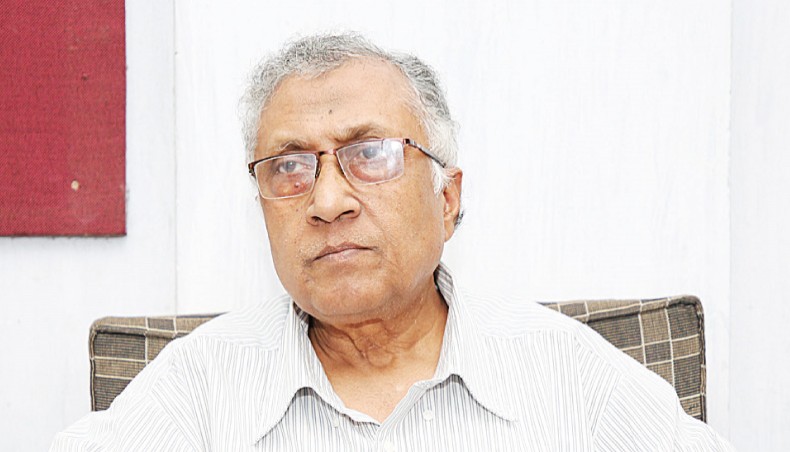Sarwar Jahan
Sarwar Jahan, director, Policy Research Institute and Professor (retired) Urban and Regional Planning at Bangladesh University of Engineering and Technology (BUET), says in an interview with New Age journalist Tapos Kanti Das and Rashad Ahamad
Illegal businesses like plastic and polythene factories and chemical businesses expanded drastically in the past couple of decades in the older part of 400-year-old Dhaka city, a very densely populated area with inadequate and narrow lanes and by-lanes.
Besides, the one or two-storey buildings here are being pulled down while multi-storey buildings are being constructed in the area in an uncontrolled way and without approval of the authorities. As a result, accidents have been occurring frequently in the area.
Now, we see frequent fire incidents in the area but one cannot even imagine what will be the scale of destruction and losses of lives if there is any earthquake – the buildings will crumble down and at the same time the area will face fire hazard as there are gas lines and chemical warehouses.
If there is any earthquake, each of the buildings of old Dhaka storing chemicals will act like powerful bomb shells — we can call it ‘time bombs’. The buildings have turned into time bombs due to uncontrolled upward expansion keeping no space in front of or by the side of buildings.
This cannot be termed ‘development’. The multi-storey buildings have been constructed and illegal businesses expanded endangering the lives of dwellers in the congested old Dhaka in absence of proper monitoring of authorities concerned.
A total of 42 government agencies work in the city corporation area in Dhaka. Separate agencies provide separate services. But there is almost no coordination with the agencies as one agency ignores other agency’s activities.
Actually, at the root of all the evils is the problem of governance.
If any problem occurs, everyone waits for the prime minister’s direction. This means, there is no decentralisation of power.
The whole country runs through several administrative organisations. They govern the country from their respective positions. But this is not happening in our country.
For example, in Japan, a city mayor governs the whole city. He is empowered and responsible for doing all the activities in his area. Chicago, a city smaller than Dhaka, is divided into around 200 units and all the local activities are done there by the local community.
We see construction of roads in Dhaka but it is not balanced. Moreover, separate agency has separate mandates to the city dwellers. As a result, if any accident occurs, one agency shifts blame to other one.
Besides, none, even the city mayor, have control over old Dhaka.
RAJUK has detailed plan about things to do and not to do in a specific area of Dhaka. They have specific directions about they have to keep away from residential houses and areas but there is almost no monitoring. Besides, it is not possible for RAJUK to implement it all.
Local government is needed to implement the plan – the city mayor and councilors can implement them. The plan will come from the city corporation or upper level but the councilors will implement the plan as they know their local community people.
For this, they need to be empowered. Less than two per cent of the national budget is allocated for local governments. What can be done with such a small amount?
The community people will have to be empowered too.
As the local governments are not empowered, they are doing what they can. As a result, all their activities are going beyond control.
We see mega projects to be implemented in the country. But what fruit it will bring if there is no development of local community.
As regards disaster management, the whole Dhaka is vulnerable but old Dhaka is the most vulnerable that witnessed two devastating fire in nine years – one at Nimtali in 2010 that killed at least 124 and the other at Chawk Bazar’s Churihatta on February 20 night that killed at least 69 so far.
Due to chemical warehouses, the vulnerability has increased many times – the fire spread in seconds. As a result, affected people would not be able to escape.
As the buildings are constructed in a congested way, leaving almost no space between two and even the roads are badly narrow, in case of any high scale earthquake, people who will manage to come out from buildings will die as they will get no open space to take shelter. In such a condition, the rescuers would not be able to reach the affected area.
It will be really devastating in old Dhaka as the flammable objects would continue to explode and the whole area will turn into fire-ground – we can term it ‘a huge bomb’.
But we should come out of the situation. For this, we need re-development. The chemical and plastic warehouses and factories should be relocated from the area.
Public buildings should be earthquake-resistant so that no harm can be caused even after earth quake of seven or eight magnitude. There should be adequate space between two buildings and adequate water reservoirs in the area.
As the area is congested, a number of people should be shifted to other places to get free spaces. But the task will not be an easy one. The community people must cooperate and the authorities must show something positive on a pilot basis.
All the things are possible if our governance system is changed and become better, if rule of law can be established and local government as well as the community people becomes empowered.






